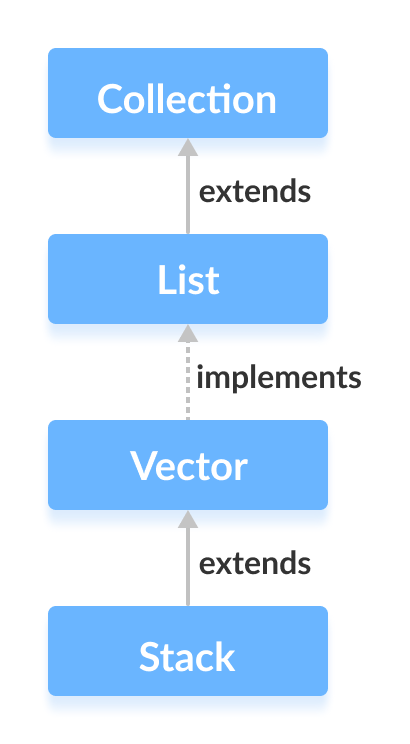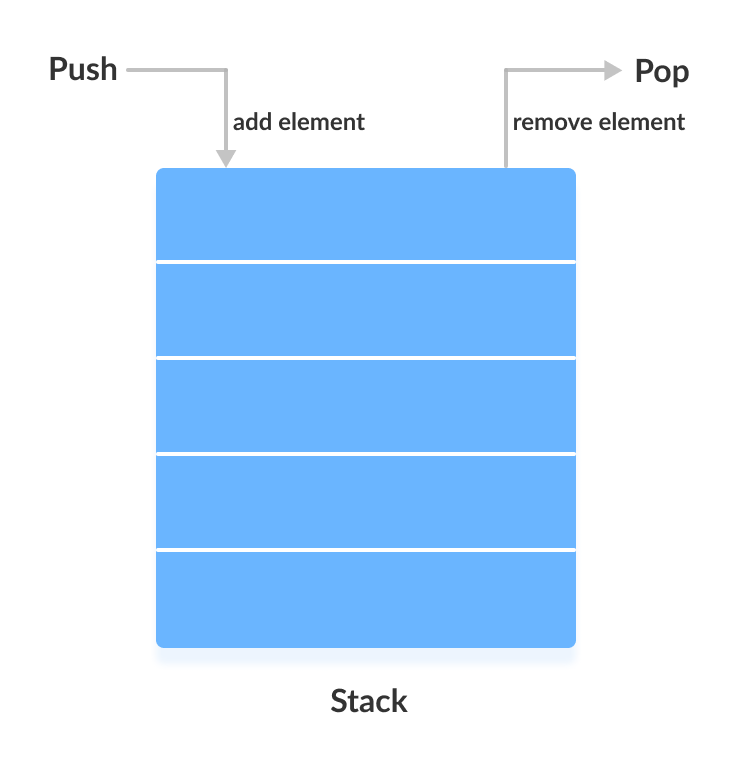The Java collections framework has a class named Stack that provides the functionality of the stack data structure.
The Stack class extends the Vector class.

Stack Implementation
In stack, elements are stored and accessed in Last In First Out manner. That is, elements are added to the top of the stack and removed from the top of the stack.

Creating a Stack
In order to create a stack, we must import the java.util.Stack package first. Once we import the package, here is how we can create a stack in Java.
Stack<Type> stacks = new Stack<>();Here, Type indicates the stack's type. For example,
// Create Integer type stack
Stack<Integer> stacks = new Stack<>();
// Create String type stack
Stack<String> stacks = new Stack<>();Stack Methods
Since Stack extends the Vector class, it inherits all the methods Vector. To learn about different Vector methods, visit Java Vector Class.
Besides these methods, the Stack class includes 5 more methods that distinguish it from Vector.
push() Method
To add an element to the top of the stack, we use the push() method. For example,
import java.util.Stack;
class Main {
public static void main(String[] args) {
Stack<String> animals= new Stack<>();
// Add elements to Stack
animals.push("Dog");
animals.push("Horse");
animals.push("Cat");
System.out.println("Stack: " + animals);
}
}Output
Stack: [Dog, Horse, Cat]
pop() Method
To remove an element from the top of the stack, we use the pop() method. For example,
import java.util.Stack;
class Main {
public static void main(String[] args) {
Stack<String> animals= new Stack<>();
// Add elements to Stack
animals.push("Dog");
animals.push("Horse");
animals.push("Cat");
System.out.println("Initial Stack: " + animals);
// Remove element stacks
String element = animals.pop();
System.out.println("Removed Element: " + element);
}
}Output
Initial Stack: [Dog, Horse, Cat] Removed Element: Cat
peek() Method
The peek() method returns an object from the top of the stack. For example,
import java.util.Stack;
class Main {
public static void main(String[] args) {
Stack<String> animals= new Stack<>();
// Add elements to Stack
animals.push("Dog");
animals.push("Horse");
animals.push("Cat");
System.out.println("Stack: " + animals);
// Access element from the top
String element = animals.peek();
System.out.println("Element at top: " + element);
}
}Output
Stack: [Dog, Horse, Cat] Element at top: Cat
search() Method
To search an element in the stack, we use the search() method. It returns the position of the element from the top of the stack. For example,
import java.util.Stack;
class Main {
public static void main(String[] args) {
Stack<String> animals= new Stack<>();
// Add elements to Stack
animals.push("Dog");
animals.push("Horse");
animals.push("Cat");
System.out.println("Stack: " + animals);
// Search an element
int position = animals.search("Horse");
System.out.println("Position of Horse: " + position);
}
}Output
Stack: [Dog, Horse, Cat] Position of Horse: 2
empty() Method
To check whether a stack is empty or not, we use the empty() method. For example,
import java.util.Stack;
class Main {
public static void main(String[] args) {
Stack<String> animals= new Stack<>();
// Add elements to Stack
animals.push("Dog");
animals.push("Horse");
animals.push("Cat");
System.out.println("Stack: " + animals);
// Check if stack is empty
boolean result = animals.empty();
System.out.println("Is the stack empty? " + result);
}
}Output
Stack: [Dog, Horse, Cat] Is the stack empty? false
Use ArrayDeque Instead of Stack
The Stack class provides the direct implementation of the stack data structure. However, it is recommended not to use it. Instead, use the ArrayDeque class (implements the Deque interface) to implement the stack data structure in Java.
Also Read: